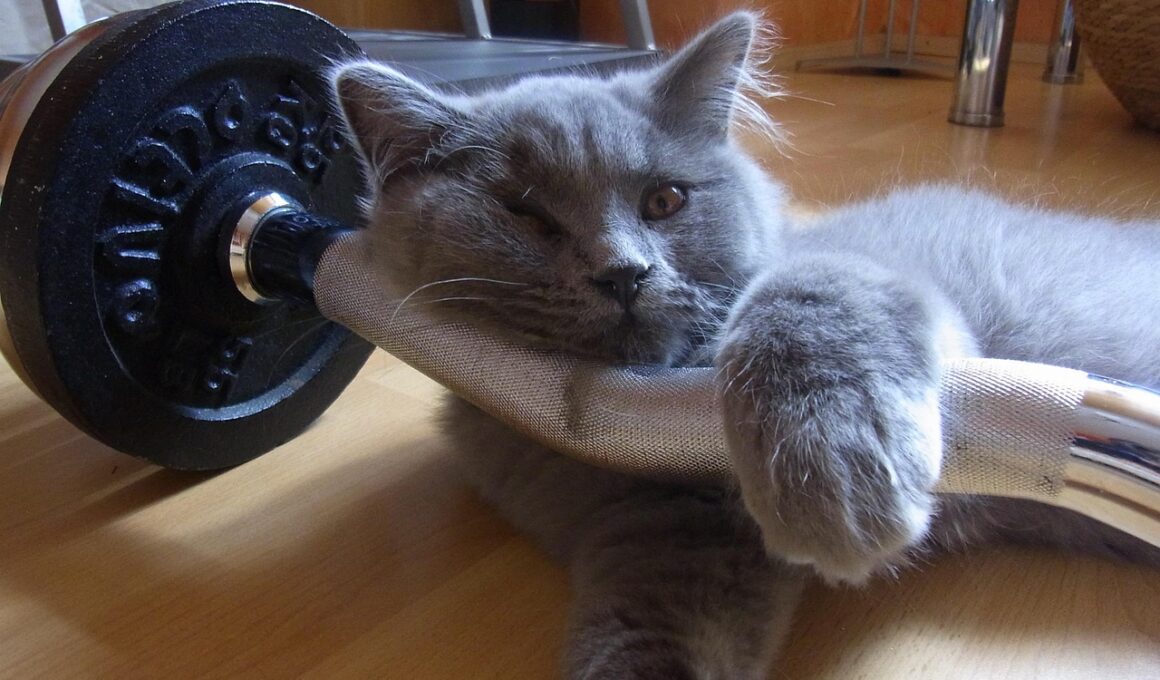Training Tips for Shy or Nervous Cats Using Equipment
Training your shy or nervous cat necessitates using the right equipment to build confidence and establish trust. Begin with a clicker, a small handheld device that makes a distinct sound when pressed. Clicking the device signifies positive reinforcement, making it essential for training. Before introducing your cat to the clicker, let them explore it safely. Reward calm behavior with treats, thereby creating a positive association with the clicker. Gradually begin to use the clicker while your cat engages in desired behaviors, ensuring to click and then offer treats immediately. This process can help shy cats understand that training can be rewarding. Additionally, consider using a long leash or harness during training sessions to give your cat safe outdoor access while still being secure. This can help reduce anxiety by allowing them to explore their environment without the immediate risk of running away. Ultimately, this approach encourages unhurried interaction with their space. Remember, every cat learns at their own pace, so patience is key during the training process to avoid further overwhelming them with their surroundings.
Another effective piece of equipment is a comfortable cat carrier, which can double as a safe space for your shy cat. Train your cat to accept the carrier by leaving it open in their living area. Place familiar smells like their bed or favorite blanket within it to encourage exploration. Avoid forcing the cat into the carrier; instead, let them enter voluntarily. Every time they approach or enter the carrier, click and treat to reinforce this positive behavior. Over time, they will associate the carrier with comfort and safety. To help your shy cat become more accustomed to human interaction, consider using interactive toys. Toys like feather wands or laser pointers let your cat engage playfully while remaining at a distance, reducing pressure. Gradual exposure to your presence through play encourages them to view engagement with humans as a safe and enjoyable experience. Additionally, use soft calming music during training to create a relaxing atmosphere, helping alleviate stress. Always keep sessions short and positive, gradually increasing their duration as your cat becomes more comfortable and confident.
Using Treats Wisely in Training
Treats play a vital role in training shy or nervous cats. However, select high-value rewards that are irresistible to your feline friends. Opt for treats that they don’t receive daily; something enticing helps maintain their interest and focus during training sessions. When introducing new equipment or techniques, use these treats generously to create a positive association with both the training and the equipment itself. Begin with simple commands or actions; for instance, use the clicker or a bell to encourage activities such as sitting or coming. As they begin to succeed, keep adding different equipment rewards, like toys or perches, reinforcing the learned behavior. Utilize the principles of gradual exposure; slowly increase the difficulty level of tasks or the equipment involved, allowing your shy cat time to adjust comfortably at their own pace. Combination practices involving reward-based sessions with gentle petting can also significantly reduce their nervousness while enhancing their social skills. Remember that sudden movements or loud noises during these training sessions can unnerve a nervous cat, so always stay calm and composed, fostering a sense of security and trust.
In learning about the environment, make use of calming aids like pheromone diffusers or stress-relief sprays. These products can help create a soothing experience during training sessions. Plug-in diffusers gradually release calming pheromones that mimic those naturally produced by cats, reducing their anxiety over time. Alternatively, carrier training combined with pheromones can create a multi-faceted relaxation approach. Through this gradual introduction process, your shy cat can learn associativity between the carrier, pheromone scent, and safety, making their training experience less frightening. Additionally, creating a designated quiet space away from distractions will allow for free exploration without overwhelming stimuli. Providing a warm blanket or their favorite bed can aid in establishing comfort through consistency in their training zone. It’s essential to monitor your cat’s body language and reactions. If signs of stress arise—like hiding or hissing—take a step back and assess the situation. Remember that you can only train them if they feel safe, so building this trust is crucial for long-term success. Your ultimate goal lies in nurturing a healthy training experience to foster a connection between you and your shy feline.
Establishing Routine and Consistency
Routine offers reassurance and security to shy cats, especially during their training. Establish a consistent schedule for training sessions, aiming for short, frequent interactions throughout the day. This approach helps your cat acclimate to the process, making it easier for them to predict outcomes and leading to a more relaxed mindset. Ensure each training session is structured similarly in terms of equipment spacing and your position in the environment. Choosing a quiet room can help minimize anxious behaviors and facilitate the process. Consistency also extends to your commands and cues; use the same words or actions each time to avoid confusing your feline friend. This clarity will encourage them to respond with confidence as they grow accustomed to what is expected of them. Take care not to lose patience, expressing empathy toward their learning pace. Allowing them to lead the interaction also fosters a natural bond. Regular accomplishments, regardless of size, create a sense of success, reinforcing their belief in themselves. Your ultimate objective in training should be to nurture a trusting relationship alongside their development and to grow their confidence through shared experiences.
Implementing visual aids, like clicker training or signal indicators, can significantly enhance communication between you and your shy cat. For example, visual markers or easily recognizable signals can convey intentions clearly, aiding in effective communication. This method helps shy cats comprehend what behaviors are desired, while simultaneously decreasing apparent pressure. You can incorporate visual cues during sessions, allowing your cat to anticipate interactions better. In addition to using visual cues, consider adding equipment that encourages social behavior, such as interactive feed boxes. These devices can stimulate mental engagement while keeping the cat positively focused, however clever designs may also relieve training monotony. Creating an environment where the cat feels confident to explore while associating toys or equipment with positive experiences fosters gradual confidence development. Always respect their unique personality; some cats may thrive on visual cues, while others require flexibility in training methods. Observe your cat’s reactions closely. If they respond positively, use those methods consistently, enhancing the connection you two share, ultimately leading to successful training outcomes that meet your cat’s needs.
Monitoring Progress and Adjustments
As you work with your shy cat, it’s crucial to continuously monitor their progress throughout the training process. Regular reflection on what strategies are effective—and which are not—will assist in adapting your approach as necessary. Keep a journal if you find it helpful, noting behaviors that seem to improve over time and those that cause stress. This documentation provides insight, identifying patterns that help recognize when to celebrate milestones versus when to re-evaluate your tactics. Remember that training isn’t a linear process; there will be ups and downs as your cat becomes more comfortable. Ensure you remain patient and willing to adjust your expectations to suit your cat’s unique learning journey. If you sense frustration in training, try a relaxed setting where your cat can explore freely, offering an opportunity for self-discovery. Soon enough, you’ll notice your shy cat engaging with you in a more relaxed manner. Striking a balance between structure and flexibility fosters an optimal training environment where exploration and comfort coexist. Ultimately, your dedication and support will create a solid foundation of trust that paves the way for learning and bonding.
In conclusion, training a shy or nervous cat using specialized equipment can lead to meaningful progress in their behavior and overall comfort. It’s essential to prioritize patience and understanding throughout the process. As you engage with your furry companion, remember to respect their boundaries and preferences, allowing them to set the pace for their training journey. Combining various techniques, like positive reinforcement, soothing environments, and structured routines, will enhance their confidence progressively. The transformation may be gradual, but with unwavering commitment from you, your shy cat can flourish into a more confident feline. Continue learning about effective training practices and remain open to adjustments as your cat develops. Additionally, keep nourishing their attachment to you through regular, positive interactions that facilitate a deepening bond over time. Celebrate each small victory in your cat’s accomplishments—they contribute significantly to motivating your little furball! By fostering an atmosphere of trust, safety, and love, you’ll witness a remarkable shift in your beloved pet’s demeanor. Embrace the journey of nurturing your shy friend into a more compassionate, courageous companion who thrives in your care.


